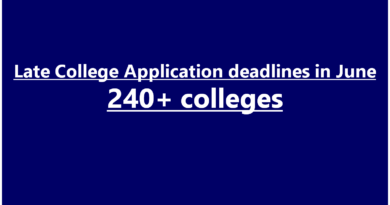Does Early Action or Decision Increase Chances of Admission?
With the competition for college admissions fiercer than ever, many students wonder if applying Early Action (EA) or Early Decision (ED) can give them a competitive edge. With these options, students may receive admissions decisions sooner, and many hope this increases their chances. But is that actually the case? Let’s explore how EA and ED work, their differences, and the ways they may impact your admission chances.
1. Early Decision vs. Early Action: What’s the Difference?
Before weighing the benefits, it’s essential to understand how EA and ED differ. Each has unique conditions, which might make one more suitable depending on a student’s goals and needs.
What is Early Decision?
Early Decision (ED) is a binding agreement. Students who apply ED commit to attending that school if accepted, and must withdraw applications to other colleges. Deadlines for ED typically fall in November, earlier than those for regular admissions.
Key Points of Early Decision:
- Binding Commitment: Acceptance means you are committed to attending.
- Single Application: You may apply ED to only one school.
- Timeline: Deadlines are often in early November, with results released by mid-December.
Choosing ED should only be an option for students who are certain about attending that particular school and are ready to accept the financial aid package offered without comparing it to other options.
What is Early Action?
Early Action (EA), unlike ED, is non-binding. You may apply EA to multiple schools, and you are not obligated to attend any of them if accepted. Like ED, EA deadlines are typically in November, and students receive decisions earlier than regular applicants.
Key Points of Early Action:
- Non-Binding: You aren’t obligated to attend if accepted.
- Multiple Applications Allowed: You can apply to multiple schools through EA.
- Timeline: Similar deadlines to ED, with decisions by December or January.
EA is ideal for students who want to show interest in a school but aren’t yet ready to commit to attending.
2. Do Early Decision and Early Action Increase Admission Chances?
While ED and EA don’t guarantee acceptance, they may offer an advantage. Colleges often value early applications because they demonstrate a student’s strong interest, which can positively impact admissions decisions.
How Early Decision Affects Acceptance Rates
Highly selective schools often offer ED, and they tend to accept a higher percentage of ED applicants than those applying during regular admissions.
- Harvard University: Harvard’s ED acceptance rate for the class of 2027 was approximately 7.6%, compared to a much lower 2.6% for regular applicants. The higher rate indicates an advantage for ED applicants, though it remains highly competitive.
- University of Pennsylvania (UPenn): In 2022, UPenn admitted about 15.6% of ED applicants, while the regular decision acceptance rate was only around 5%. Schools like UPenn use ED as a way to secure students who are committed to attending if accepted.
However, higher acceptance rates for ED applicants do not mean the process is less rigorous. Students applying through ED must still meet all academic and extracurricular benchmarks set by the school.
How Early Action Affects Acceptance Rates
For schools that offer EA, students also tend to have slightly higher acceptance rates than regular applicants. However, the advantage of EA is usually less pronounced than ED due to its non-binding nature.
- University of Michigan: Michigan offers EA, and a large percentage of its accepted students apply this way. EA applicants receive priority consideration, with around 27% acceptance for EA compared to lower rates for regular admissions.
- Auburn University: Auburn’s EA process allows students to indicate serious interest. Roughly 44% of their admitted class was through EA, showing that EA applicants are given priority, though not necessarily a substantial advantage.
The advantage of EA lies in its ability to signal interest and gain early feedback without locking into a single choice.
3. Why Do Colleges Favor Early Applicants?
Several factors contribute to why colleges may favor students who apply early:
- Improved Yield Rates: Schools aim for high yield rates (the percentage of admitted students who enroll). ED is binding, so applicants who accept are guaranteed to attend. This strengthens yield rates, improving a school’s rankings and prestige.
- Demonstrated Interest: For colleges, early applications reflect strong interest in the school. ED applicants, in particular, signal their enthusiasm and commitment, which can positively influence admissions decisions.
However, neither ED nor EA is a guaranteed pathway. Colleges still prioritize applicants who meet their academic and extracurricular standards.
4. Pros and Cons of Applying Early Decision or Early Action
While EA and ED have distinct benefits, there are potential drawbacks to consider.
Pros of Early Decision
- Higher Acceptance Rates: Many schools have a higher acceptance rate for ED applicants, which can be beneficial if you are a strong candidate.
- Reduced Stress: Knowing you’ve been accepted in December can alleviate the pressure of waiting until spring for regular decisions.
Cons of Early Decision
- Limited Financial Flexibility: Because you’re required to accept the offer if admitted, you won’t have the option to compare financial aid packages from other schools.
- Increased Pressure: Committing to a school in November can be challenging, especially if you haven’t had the time to evaluate all your options fully.
Pros of Early Action
- Flexibility: EA allows you to apply to multiple schools and doesn’t require commitment, giving you more options.
- Early Response: EA applicants receive admissions decisions sooner, which can reduce the anxiety of waiting.
Cons of Early Action
- Limited Advantage: The acceptance advantage of EA is usually smaller than ED, as EA does not guarantee enrollment.
- Increased Competition: Since EA isn’t binding, it often attracts more applicants, making the pool more competitive.
5. Is Early Decision or Early Action Right for You?
The decision to apply ED or EA should be based on your commitment to a school, your competitiveness as a candidate, and your financial circumstances.
When Early Decision May Be the Right Choice
Choose ED if you:
- Are Committed to One School: ED is best for students who have a clear favorite and would attend that school if accepted.
- Are a Strong Applicant: Make sure you meet or exceed the admission criteria. ED applications are often from highly qualified students.
- Understand the Financial Obligations: Be prepared to accept the financial aid package offered, as you won’t be able to compare it with others.
When Early Action May Be the Right Choice
Choose EA if you:
- Want More Time to Decide: EA is ideal for students who are interested in several schools but aren’t ready to commit.
- Are Looking for Early Feedback: EA allows you to receive an early decision and potentially reduce the time and cost of applying to more schools.
- Want Reduced Stress During Senior Year: Receiving an acceptance through EA can lighten the stress of the regular admissions cycle.
6. How to Make the Final Decision: Early Decision, Early Action, or Regular Admission?
Ultimately, the choice to apply ED or EA depends on your priorities, the schools you are targeting, and your overall college goals. If you’re confident in your first-choice school and meet its requirements, ED might offer an advantage. If you want flexibility but still value an early response, EA may be a better fit.
Steps to Decide If Early Applications Are Right for You
- Research School Policies: Understand each school’s stance on early applications and how much weight they place on ED or EA.
- Evaluate Financial Considerations: ED may limit your ability to compare aid packages, so consider your financial needs carefully.
- Consult Admissions Counselors: If you’re uncertain, reach out to admissions representatives for insights into how each school views early applications.
7. Final Takeaway
Applying Early Decision or Early Action can be a strategic move, especially if you have a clear top-choice school or want an early admissions response. While both options can boost your odds, particularly at highly selective schools, neither is a guaranteed ticket to admission. Evaluate your options carefully, do your research, and consider your goals and financial needs. By weighing all factors, you’ll be able to make the best choice for your college application strategy.



